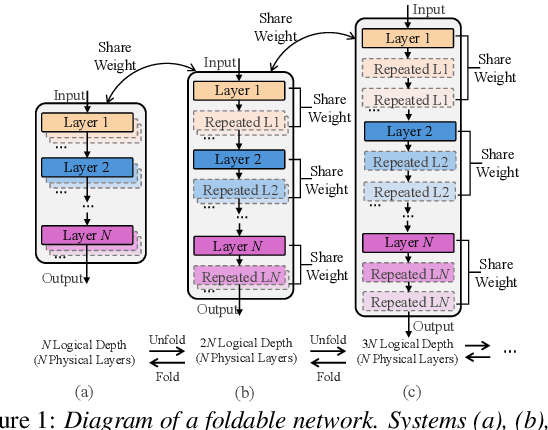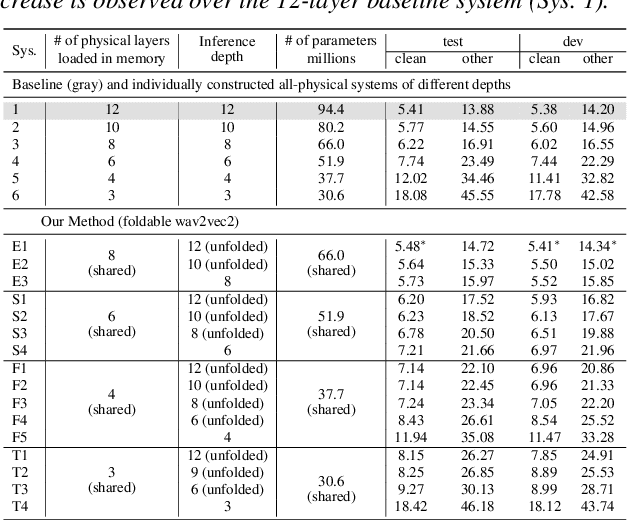Zengrui Jin
SPEAR: A Unified SSL Framework for Learning Speech and Audio Representations
Oct 29, 2025Abstract:Self-Supervised Learning (SSL) excels at learning generic representations of acoustic signals, yet prevailing methods remain domain-specific, tailored to either speech or general audio, hindering the development of a unified representation model with a comprehensive capability over both domains. To address this, we present SPEAR (SPEech and Audio Representations), the first SSL framework to successfully learn unified speech and audio representations from a mixture of speech and audio data. SPEAR proposes a unified pre-training objective based on masked prediction of fine-grained discrete tokens for both speech and general audio. These tokens are derived from continuous speech and audio representations using a Multi-codebook Vector Quantisation (MVQ) method, retaining rich acoustic detail essential for modelling both speech and complex audio events. SPEAR is applied to pre-train both single-domain and unified speech-and-audio SSL models. Our speech-domain model establishes a new state-of-the-art on the SUPERB benchmark, a speech processing benchmark for SSL models, matching or surpassing the highly competitive WavLM Large on 12 out of 15 tasks with the same pre-training corpora and a similar model size. Crucially, our unified model learns complementary features and demonstrates comprehensive capabilities across two major benchmarks, SUPERB and HEAR, for evaluating audio representations. By further scaling up the model size and pre-training data, we present a unified model with 600M parameters that excels in both domains, establishing it as one of the most powerful and versatile open-source SSL models for auditory understanding. The inference code and pre-trained models will be made publicly available.
Towards One-bit ASR: Extremely Low-bit Conformer Quantization Using Co-training and Stochastic Precision
May 27, 2025Abstract:Model compression has become an emerging need as the sizes of modern speech systems rapidly increase. In this paper, we study model weight quantization, which directly reduces the memory footprint to accommodate computationally resource-constrained applications. We propose novel approaches to perform extremely low-bit (i.e., 2-bit and 1-bit) quantization of Conformer automatic speech recognition systems using multiple precision model co-training, stochastic precision, and tensor-wise learnable scaling factors to alleviate quantization incurred performance loss. The proposed methods can achieve performance-lossless 2-bit and 1-bit quantization of Conformer ASR systems trained with the 300-hr Switchboard and 960-hr LibriSpeech corpus. Maximum overall performance-lossless compression ratios of 16.2 and 16.6 times are achieved without a statistically significant increase in the word error rate (WER) over the full precision baseline systems, respectively.
Unfolding A Few Structures for The Many: Memory-Efficient Compression of Conformer and Speech Foundation Models
May 27, 2025



Abstract:This paper presents a novel memory-efficient model compression approach for Conformer ASR and speech foundation systems. Our approach features a unique "small-to-large" design. A compact "seed" model containing a few Conformer or Transformer blocks is trained and unfolded many times to emulate the performance of larger uncompressed models with different logical depths. The seed model and many unfolded paths are jointly trained within a single unfolding cycle. The KL-divergence between the largest unfolded and smallest seed models is used in a self-distillation process to minimize their performance disparity. Experimental results show that our foldable model produces ASR performance comparable to individually constructed Conformer and wav2vec2/HuBERT speech foundation models under various depth configurations, while requiring only minimal memory and storage. Conformer and wav2vec2 models with a reduction of 35% and 30% parameters are obtained without loss of performance, respectively.
Effective and Efficient Mixed Precision Quantization of Speech Foundation Models
Jan 07, 2025



Abstract:This paper presents a novel mixed-precision quantization approach for speech foundation models that tightly integrates mixed-precision learning and quantized model parameter estimation into one single model compression stage. Experiments conducted on LibriSpeech dataset with fine-tuned wav2vec2.0-base and HuBERT-large models suggest the resulting mixed-precision quantized models increased the lossless compression ratio by factors up to 1.7x and 1.9x over the respective uniform-precision and two-stage mixed-precision quantized baselines that perform precision learning and model parameters quantization in separate and disjointed stages, while incurring no statistically word error rate (WER) increase over the 32-bit full-precision models. The system compression time of wav2vec2.0-base and HuBERT-large models is reduced by up to 1.9 and 1.5 times over the two-stage mixed-precision baselines, while both produce lower WERs. The best-performing 3.5-bit mixed-precision quantized HuBERT-large model produces a lossless compression ratio of 8.6x over the 32-bit full-precision system.
Structured Speaker-Deficiency Adaptation of Foundation Models for Dysarthric and Elderly Speech Recognition
Dec 25, 2024Abstract:Data-intensive fine-tuning of speech foundation models (SFMs) to scarce and diverse dysarthric and elderly speech leads to data bias and poor generalization to unseen speakers. This paper proposes novel structured speaker-deficiency adaptation approaches for SSL pre-trained SFMs on such data. Speaker and speech deficiency invariant SFMs were constructed in their supervised adaptive fine-tuning stage to reduce undue bias to training data speakers, and serves as a more neutral and robust starting point for test time unsupervised adaptation. Speech variability attributed to speaker identity and speech impairment severity, or aging induced neurocognitive decline, are modelled using separate adapters that can be combined together to model any seen or unseen speaker. Experiments on the UASpeech dysarthric and DementiaBank Pitt elderly speech corpora suggest structured speaker-deficiency adaptation of HuBERT and Wav2vec2-conformer models consistently outperforms baseline SFMs using either: a) no adapters; b) global adapters shared among all speakers; or c) single attribute adapters modelling speaker or deficiency labels alone by statistically significant WER reductions up to 3.01% and 1.50% absolute (10.86% and 6.94% relative) on the two tasks respectively. The lowest published WER of 19.45% (49.34% on very low intelligibility, 33.17% on unseen words) is obtained on the UASpeech test set of 16 dysarthric speakers.
k2SSL: A Faster and Better Framework for Self-Supervised Speech Representation Learning
Nov 26, 2024Abstract:Self-supervised learning (SSL) has achieved great success in speech-related tasks, driven by advancements in speech encoder architectures and the expansion of datasets. While Transformer and Conformer architectures have dominated SSL backbones, encoders like Zipformer, which excel in automatic speech recognition (ASR), remain unexplored in SSL. Concurrently, inefficiencies in data processing within existing SSL training frameworks, such as fairseq, pose challenges in managing the growing volumes of training data. To address these issues, we propose k2SSL, an open-source framework that offers faster, more memory-efficient, and better-performing self-supervised speech representation learning, with a focus on downstream ASR tasks. The optimized HuBERT and proposed Zipformer-based SSL systems exhibit substantial reductions in both training time and memory usage during SSL training. Experiments on LibriSpeech and Libri-Light demonstrate that Zipformer-based SSL systems significantly outperform comparable HuBERT and WavLM systems, achieving a relative WER reduction on dev-other/test-other of up to 34.8%/32.4% compared to HuBERT Base after supervised fine-tuning, along with a 3.5x pre-training speedup in total GPU hours.
CR-CTC: Consistency regularization on CTC for improved speech recognition
Oct 07, 2024



Abstract:Connectionist Temporal Classification (CTC) is a widely used method for automatic speech recognition (ASR), renowned for its simplicity and computational efficiency. However, it often falls short in recognition performance compared to transducer or systems combining CTC and attention-based encoder-decoder (CTC/AED). In this work, we propose the Consistency-Regularized CTC (CR-CTC), which enforces consistency between two CTC distributions obtained from different augmented views of the input speech mel-spectrogram. We provide in-depth insights into its essential behaviors from three perspectives: 1) it conducts self-distillation between random pairs of sub-models that process different augmented views; 2) it learns contextual representation through masked prediction for positions within time-masked regions, especially when we increase the amount of time masking; 3) it suppresses the extremely peaky CTC distributions, thereby reducing overfitting and improving the generalization ability. Extensive experiments on LibriSpeech, Aishell-1, and GigaSpeech datasets demonstrate the effectiveness of our CR-CTC, which achieves performance comparable to, or even slightly better than, that of transducer and CTC/AED.
LibriheavyMix: A 20,000-Hour Dataset for Single-Channel Reverberant Multi-Talker Speech Separation, ASR and Speaker Diarization
Sep 01, 2024



Abstract:The evolving speech processing landscape is increasingly focused on complex scenarios like meetings or cocktail parties with multiple simultaneous speakers and far-field conditions. Existing methodologies for addressing these challenges fall into two categories: multi-channel and single-channel solutions. Single-channel approaches, notable for their generality and convenience, do not require specific information about microphone arrays. This paper presents a large-scale far-field overlapping speech dataset, crafted to advance research in speech separation, recognition, and speaker diarization. This dataset is a critical resource for decoding ``Who said What and When'' in multi-talker, reverberant environments, a daunting challenge in the field. Additionally, we introduce a pipeline system encompassing speech separation, recognition, and diarization as a foundational benchmark. Evaluations on the WHAMR! dataset validate the broad applicability of the proposed data.
Advancing Multi-talker ASR Performance with Large Language Models
Aug 30, 2024



Abstract:Recognizing overlapping speech from multiple speakers in conversational scenarios is one of the most challenging problem for automatic speech recognition (ASR). Serialized output training (SOT) is a classic method to address multi-talker ASR, with the idea of concatenating transcriptions from multiple speakers according to the emission times of their speech for training. However, SOT-style transcriptions, derived from concatenating multiple related utterances in a conversation, depend significantly on modeling long contexts. Therefore, compared to traditional methods that primarily emphasize encoder performance in attention-based encoder-decoder (AED) architectures, a novel approach utilizing large language models (LLMs) that leverages the capabilities of pre-trained decoders may be better suited for such complex and challenging scenarios. In this paper, we propose an LLM-based SOT approach for multi-talker ASR, leveraging pre-trained speech encoder and LLM, fine-tuning them on multi-talker dataset using appropriate strategies. Experimental results demonstrate that our approach surpasses traditional AED-based methods on the simulated dataset LibriMix and achieves state-of-the-art performance on the evaluation set of the real-world dataset AMI, outperforming the AED model trained with 1000 times more supervised data in previous works.
Empowering Whisper as a Joint Multi-Talker and Target-Talker Speech Recognition System
Jul 13, 2024Abstract:Multi-talker speech recognition and target-talker speech recognition, both involve transcription in multi-talker contexts, remain significant challenges. However, existing methods rarely attempt to simultaneously address both tasks. In this study, we propose a pioneering approach to empower Whisper, which is a speech foundation model, to tackle joint multi-talker and target-talker speech recognition tasks. Specifically, (i) we freeze Whisper and plug a Sidecar separator into its encoder to separate mixed embedding for multiple talkers; (ii) a Target Talker Identifier is introduced to identify the embedding flow of the target talker on the fly, requiring only three-second enrollment speech as a cue; (iii) soft prompt tuning for decoder is explored for better task adaptation. Our method outperforms previous methods on two- and three-talker LibriMix and LibriSpeechMix datasets for both tasks, and delivers acceptable zero-shot performance on multi-talker ASR on AishellMix Mandarin dataset.
 Add to Chrome
Add to Chrome Add to Firefox
Add to Firefox Add to Edge
Add to Edge